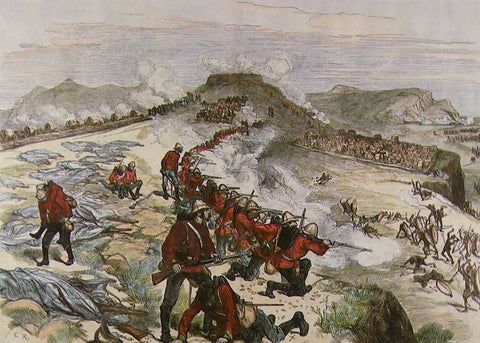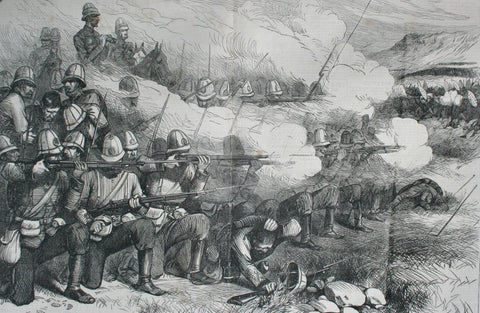The Anglo-Zulu War of 1879

The Anglo-Zulu War of 1879 remains one of the most dramatic in both British and southern African history, and has been immortalized in at least two feature films, ZULU and ZULU DAWN. In retrospect, the war was provoked by an unwarranted act of British aggression.
The Zulu kingdom had first emerged early in the nineteenth century, with its heartland lying along the eastern seaboard of southern Africa, north of modern Durban. Within a few years, British adventurers were attracted to Zululand in search of trade and profit, and by the 1840s a British colony - Natal - had sprung up on the southern borders of Zululand. By the 1870s, the British had begun to adopt a forward policy in the region, hoping to bring the various British colonies, Boer republics and independent African groups under common control, with a view to implementing a policy of economic development. The British High Commissioner in South Africa, Sir Henry Bartle Frere, believed that the robust and economically self-reliant Zulu kingdom was a threat to this policy.

In December 1878 he picked a quarrel with the Zulu king, Cetshwayo kaMpande, in the belief that the Zulu army - armed primarily with shields and spears - would soon collapse in the face of British Imperial might. The war began in January 1879. Three columns of British troops under the command of Lt. Gen. Lord Chelmsford invaded Zululand. Almost immediately, the war went badly wrong for the British.

On 22 January, the Centre Column, under Lord Chelmsford's personal command, was defeated at Isandlwana mountain. In one of the worst disasters of the Colonial era, over 1300 British troops and their African allies were killed. In the aftermath of Isandlwana, the Zulu reserves mounted a raid on the British border post at Rorke's Drift, which was held by just 145 men. After ten hours of ferocious fighting, the Zulu were driven off. Eleven of the defenders of Rorke's Drift were awarded the Victoria Cross.
Caption: Some of the defenders of Rorke's Drift; men of B Company, 2/24th, photographed in Pinetown, September 1879
The British flanking columns also saw action that same day. On the coast, the right flank column brushed aside Zulu resistance at the Nyezane river, before advancing to occupy the deserted mission station at Eshowe. The left flank column was also involved in heavy skirmishing around the Hlobane mountain. The British collapse at Isandlwana left the flanking columns exposed, however. The Zulus managed to cut Col. Pearson right-flank column off from the border, and Pearson's men were besieged for three months at Eshowe. Only the left flank column remained operative.
Caption: Skirmishing on Hlobane Mountain
The success at Isandlwana exhausted the Zulu army, however, and Cetshwayo was unable to mount a counter-offensive into Natal. This gave Lord Chelmsford time to regroup. British troops were rushed to South Africa from around the Empire. By the end of March the war was poised to enter a new phase. Lord Chelmsford assembled a column to march to the relief of Eshowe, and directed the commander of the Left Flank Column - Sir Evelyn Wood - to make a diversionary attack. Wood's men attacked a local Zulu stronghold - Hlobane mountain - on 28 March, but were surprised by the unexpected arrival of the main Zulu army, and scattered. The following day, however, the Zulu attacked Wood's camp at Khambula, and after several hours of heavy fighting, were driven off.

Caption: The decisive moment at the battle of Khambula - Major Hackett's sortie
Meanwhile Lord Chelmsford had crossed into Zululand, marching towards Eshowe. On 2nd April he broke through the Zulu cordon around Eshowe at kwaGingindlovu, and relieved Pearson's column. The defeat of the Zulu king's forces in two actions, at either end of the country, and within days of each other, demoralised the Zulu, and proved to be the turning point of the war.
Caption: Finding the body of the Prince Imperial, 2 June 1879
Lord Chelmsford reorganised his forces, and in late May was poised to mount a new invasion of Zululand. This, too, began badly, when, on 1 June, the exiled Prince Imperial of France, Louis Napoleon, who was serving with the British in an unofficial capacity, was killed in a skirmish. Nevertheless, British troops continued to advance towards the Zulu capital, Ulundi, which they reached at the end of June. On 4 July Chelmsford defeated the Zulu army in the last great battle of the war. Ulundi was put to the torch, and King Cetshwayo fled. Chelmsford resigned after the victory at Ulundi, but it took several weeks for the British to suppress lingering resistance in the outlying districts. King Cetshwayo was eventually captured and sent into exile at Cape Town. The British divided his country up among thirteen pro-British chiefs - a deliberately divisive move which led to a decade of destructive civil war.
Caption: Battle of Ulundi
CHRONOLOGY
1878
11 December British present an ultimatum to King Cetshwayo
1879
11 January War begins; British invade Zululand in three columns.
22 January Col. Pearson's column defeats Zulus at Nyezane river
Lord Chelmsford's column defeated at Isandlwana
Zulu attack on the mission station at Rorke's Drift
Col. Wood's column engages in inconclusive skirmishing near Hlobane mountain.
12 March Convoy of the 80th Regt. over-run at Ntombe River, northern Zululand
28 March Col. Wood's expedition against Hlobane Mountain heavily defeated.
29 March Zulu attack on Wood's base at Khambula repulsed.
2 April Lord Chelmsford defeats Zulus investing Eshowe at kwaGingindlovu.
1st June Second British invasion begins; Prince Imperial of France killed in skirmish.
4 July Lord Chelmsford defeats Zulu at Ulundi.
28 August King Cetshwayo captured in the Ngome forest by British Dragoons
4 September Skirmising in the Ntombe valley near Luneburg; the last shots of the war



